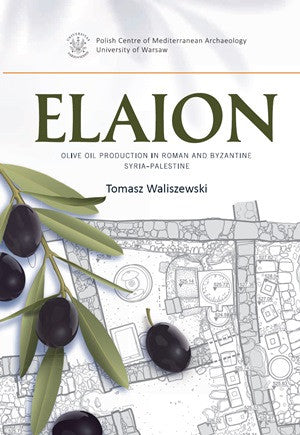Elaion, Olive Oil Production in Roman and Byzantine Syria Palestine
110,00 $
ISBN: 978-83-235-1345-2
Description: paperback, 631 pp. (29,5x21 cm), figs., plates
Condition: new
Weight: 1950g.
Tomasz Waliszewski, Elaion, Olive Oil Production in Roman and Byzantine Syria Palestine, PAM Monograph Series volume 6, Polish Centre of Mediterranean Archaeology, University of Warsaw 2014
Oleoculture was always an important part of ancient agriculture, which was the mainstay of the ancient economy and the writing on the subject, both ancient and modern, is immense. The present study centers upon the place of the olive in the agricultural regimes and economies of Roman and Byzantine Syria–Palestine, exploring them in environmental, technological, social and, when possible, economic contexts.
The author explores the regional origins of olive cultivation and its wanderings across time and space, discussing typology and chronology of oil facilities and their rural and urban contexts, as well as the economics of production and logistics of olive oil distribution.
The book opens with a synthetic presentation of oil production in Roman and Byzantine Syria–Palestine, based for the most part on data, which is gathered and presented in the second part as well as in an online resource, comprising new evidence from Syria, Lebanon and Jordan, as well as an overview of previously available data from Palestine, supplemented with information on the latest discoveries. Prominent among the data from Lebanon are hitherto unpublished records from PCMA excavations in Chhîm and Jiyeh, directed by Tomasz Waliszewski.
Foreword
Introduction
Chapter one:
Sources and resources for the study of oleoculture in Roman and Byzantine Syria–Palestine
1.1 Recent scholarship on olive oil production in the Greco-Roman Mediterranean
1.1.1 Agronomists, inventors and travelers
1.1.2 New discoveries, new perspectives
1.1.3 Review of olive oil production in the Greco-Roman Mediterranean
1.1.3.1
Africa
1.1.3.2
Tripolitania
1.1.3.3
Africa Proconsularis
1.1.3.4
Numidia and Mauretania
General characteristics
1.1.3.5
Baetica and Tarraconensis
1.1.3.6
Gallia Narbonensis
1.1.3.7
Italy
1.1.3.8
Balkans
1.1.3.9
Greece
1.1.3.10
Crete
1.1.3.11
Asia Minor
1.1.3.12
Cyprus
1.1.3.13
Egypt
1.1.3.14
Towards a
comprehensive view of olive oil production in the Greco-Roman
Mediterranean
1.2 Situating evidence for olive oil production in the Syro-Palestinian context
1.2.1 Written evidence
1.2.1.1
Roman, Byzantine and early Islamic sources
General works concerning olive tree cultivation and olive oil production
1.2.2 Sources directly referring to Syria–Palestine
1.2.2.1
Before the Greeks and Romans
Ebla and Ugarit
Bible
1.2.2.2
Greek, Latin, Hebrew, Aramaic, Syriac and Arabic
sources from the 1st millennium AD
Histories and geographies
Lives of illustrious men
Libanius’s Orations
Farming manuals
Legal texts
Jewish sources from the Mishnah and Talmud period
1.2.3 Papyrological and epigraphic sources
1.2.3.1 Papyri
2.1.3.2 Epigraphy
1.3 Archaeological evidence
1.3.1 Excavations and surveys
1.3.2 Ceramic containers
1.3.3 Iconography
1.3.4 Ecofacts and contribution of environmental analysis
1.4 Ethnography
1.4.1 European travelers’ accounts
1.4.2 Ottoman period sources
1.4.3 Modern ethnographical research
1.5 Strengths and limitations of the sources
Chapter two: Biogeography of the olive tree in its Syro–Palestinian environment
2.1 Olive tree and its domestication
2.2 Factors modeling Syro–Palestinian environment
2.2.1 Physiography
2.2.2 Pedogeography
2.2.3 Water resources
2.2.4 Climate and its fluctuations
2.2.5 Climate in Syria–Palestine different in antiquity?
2.2.6 Conclusions
2.3 Historical phytogeography of the olive tree in Syria–Palestine
2.3.1 Original vegetation cover
2.3.2 Paleobotanical evidence of the
Olea europaea
2.3.3 Conclusions
2.4 Olive tree cultivation
2.4.1 Modern and ancient cultivars
2.4.2 Methods of cultivation
2.4.3 Harvesting and productivity
2.4.4 Conclusions
Chapter three: The oil presses and their product
3.1 Production technology
3.2 Olive oil installations in Bronze and Iron Age Syria–Palestine
3.3 Typology and chronology of oil installations
3.3.1 Simple installations (Type A)
3.3.2 Lever presses (Types B to G)
3.3.2.1 Lever-and-weights presses (Type B)
3.3.2.2 Beam weights (Type C)
3.3.2.3 Lever-and-drum press (Type D)
3.3.2.4 Lever-and-screw press (Type E)
3.3.2.5 Slotted and perforated piers (Type F)
3.3.2.6 Screw weights (Type G)
3.3.3 Direct pressure rigid frame press (Types H, J and K)
3.3.4 Crushing devices (Types L and M)
3.3.5 Typology and chronology
3.3.6 Local and foreign traditions in Syro-Palestinian oil installations
3.3.7 Manufacturing of press elements, maintenance and repairs
3.4 Oil facilities in their context
3.4.1 Olive oil producing regions
3.4.1.1 Syria
3.4.1.2 Phoenicia
3.4.1.3 Transjordan
3.4.1.4 Palestine
3.4.1.5 Olive oil production in an environmental context
3.4.2 Oil press facilities in architectural and settlement context
3.4.2.1 Buildings
3.4.2.2
Oil installations in rural agglomerations
The Tel Bet Shemesh regional study
3.4.2.3 Oil installations in urban settlements
3.4.2.4 Olive oil presses and sanctuaries
3.4.2.5 Oil installations in monasteries
3.4.2.6 Oil installations and wine production
3.4.3 Productivity and yield of oil installations
3.4.4 Olive oil and its properties
3.4.5 Production of oil from other resources
3.4.6 Oil industry terminology
3.5 Conclusion
Chapter four: Olive oil production in a social and economic context
4.1 Manufacturers
4.1.1
Man, land and workshop
4.1.2 Oil production economics
4.1.3 Conclusion
4.2 Distribution logistics
4.2.1
Storage and warehouses
4.2.2 Transport containers
4.2.3 Transportation geography
4.3 Patterns of trade: wholesale and retail
4.3.1 Intra- and interregional trade
4.3.2 Costs and pricing
4.3.3 Towards a model of transport and trade for olive oil in Syria–Palestine
4.4 Consumption
4.4.1 Population, consumers and demand
4.4.2 Local diet and consumption
4.4.3 Conclusions
4.5 Syro-Palestinian olive oil production in its Eastern Mediterranean economic context
4.5.1
Demand and supply. Trends in Eastern Mediterranean economics during the 1st millennium AD
4.5.2 Roman and Byzantine Mediterranean olive oil production
4.5.3
Toward conclusions: Olive oil production in the context of the Roman and Byzantine economy of Syria–Palestine
Chapter five: Conclusions
Chapter six: Toward a new horizon – olive oil production in the Medieval Levant
6.1 Early Islamic period
6.2 Levant of the Crusaders
6.3 Ottoman period
6.4 Conclusions
Maps
List of plates
Syria
Lebanon
Jordan
Palestine
Descirptive catalog
General note
Descriptive catalog of selected Hellenistic, Roman, Byzantine and Early Islamic oil presses
A Palmyra (Syria)
B Lebanon
C Jordan
Appendix I: The Tel Bet Shemesh regional case study
Appendix II:
Analysis of samples of stone from Chhîm (Lebanon)
Irena Koss, Kamila Załęska
Bibliography
Abbreviations
Primary sources
Secondary sources
List of figures
Indices

